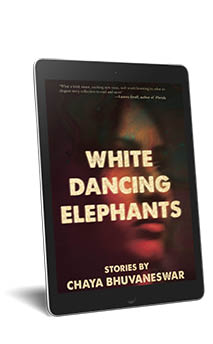READ AN EXCERPT

In the back of the house there is a corner room that does not open onto the lush and well-tended garden. Its shutters are indolent eyelids opening and closing with the wind. Light comes in small beams from the courtyard where pots are being washed. A woman is sweeping dirty water away from the steps outside the window. At a certain spot behind the empty teak wardrobe that barricades the door, all noises from the courtyard where and the kitchen it adjoins are muffled by thick wood. Crouching there, it is not possible to hear the women shouting at each other, mistress to servant and back again, scolding and fretting, cramming the small house full of nervous life.
Flat on my stomach, facing the wall, I can look at my paintings. They are vivid miniatures, set low, near the molding. Their tiny faces sport green Kathakali dancing masks, leering with painted lips and yellow hair like aging American starlets, their glossy eyes faded. My paints have dried in large, expensive tubes littered on the floor, strewn in the dust along with tiny sable brushes that were once a woman’s accessories. The mirror on the wall is British, cracked and decadent looking with too many faded gilt curlicues around it. Amid old newspapers and combs black with hair dye, I keep my shaving kit, and my traveling case. The mirror, like the room, is dark. When I look into it I see the sweat on my forehead and chin and wonder how it remains in the air-conditioned coolness.
I shelter myself from the house with second-hand screens, four of them, made of wood that looks better for the dust on it, less costly and more secure. I write after the others have gone to bed, hiding my diaries and papers during daylight hours. Sometimes their faces flash by me in the darkness, as if they were peering in rudely through a space between the screens. Only the visitors are overcome by curiosity; the niece from the States who looks at me with her little cat face, jeans curving around soft plump hips; my sister the doctor, talking about leper colonies at tea, bringing medicine and the toasters when she comes, making the house smell of Ben-Gay and bread. Even the trees in the garden move away from the house, as if in disgust. The living room is brightly lit behind embroidered cotton drapes. On each evening of her stay, from behind the screens, crouching. I hear the news on television and listen to loud, excited voices talking above it, nearly drowning it out. The niece is always quiet when her mother and my father shout about corruption and bribery or point to picket signs and angry crowds when they appear on the old-fashioned screen.
No one in this house knows that I listen to a radio hidden in my room, and that I read imported copies of The Herald Tribune. Or that I spend the money given to me by Father on tobacco, and go to the same place almost every afternoon with my pockets bulging. Nixon, Watergate—my sister doesn’t know how much I know, how much I hold fast in my memory from those times. Imprisonment, Emergency. Who wouldn’t have been paranoid then? But it’s my sister who’s the smart one, the doctor lady. She thinks of us as dull witted rice eaters waiting for her borrowed Anglo china plates and blue jeans, silk ties and pantyhose, perfume in fish shaped bottles, white linen napkins and forks so we won’t eat with our hands, expensive bolts of brilliant cloth—smelling slightly of glue, precious…”The exchange rate is wonderful,” my sister remarks, at least with the grace to laugh uneasily. Once she brought paints on a visit—“Padma picked them out specially,” she explained, handing over a shiny gift-wrapped box. Padma’s gift. They are beautiful and useless now. Exotic.
About The Book
In luminous, vivid, searingly honest prose, the stories in White Dancing Elephants center on the experiences of diverse women of color—cunning, bold, and resolute—facing sexual harassment and racial violence, as well as the violence women inflict upon each other. One woman’s miscarriage is juxtaposed against the story of the Buddha’s birth. Another cheats with her best friend’s husband, only to discover it’s her friend she most yearns for. In three different stories, three artists struggle to push courageous works into the world, while a woman with an incurable disease competes with her engineer husband’s beautiful android.

Continue Reading…
Article originally Published in the February/March 2020 Issue “Short Stories”
